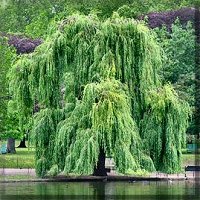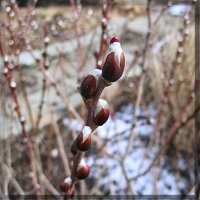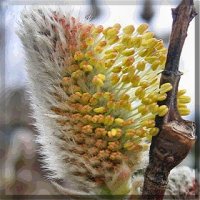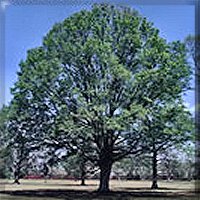



Weeping Willow Pussy Willow stage 2 Pussy Willow stage 3 Willow Oak




Weeping
Willow Pussy
Willow stage 2 Pussy
Willow stage 3 Willow
Oak
Description - The willows are deciduous trees and shrubs in the genus Salix, part of the willow family Salicaceae. There are about 350 species in this genus worldwide, found primarily on moist soils in cooler zones in the Northern Hemisphere. The leaves are deciduous, often elongate but round to oval in a few species, and with a serrated margin. Willows are dioecious with male and female flowers appearing as catkins on different plants; the catkins are produced early in the spring, often before the leaves or as the new leaves open. The fruit is a small capsule containing numerous tiny (0.1 mm) seeds embedded in white down, which assists wind dispersal of the seeds. Willows are very cross-fertile and numerous hybrids are known, both naturally occurring and in cultivation.
Family - About 350, including:
Salix acutifolia - Violet Willow,Salix alaxensis - Alaska Willow, Salix alba - White Willow, Salix alpina - Alpine Willow , Salix amygdaloides - Peachleaf Willow, Salix arbuscula - Mountain Willow, Salix arbusculoides - Littletree Willow, Salix arctica - Arctic Willow, Salix atrocinerea, Salix aurita - Eared Willow, Salix babylonica - Peking Willow, Salix bakko, Salix barrattiana - Barratt's Willow, Salix bebbiana - Beaked Willow, Salix boothii - Booth Willow, Salix bouffordii, Salix brachycarpa - Barren-ground Willow, Salix cacuminis, Salix canariensis, candida" candida>Salix candida - Sage Willow, Salix caprea - Goat Willow, cSalix caroliniana - Coastal Plain Willow, Salix chaenomeloides, Salix chilensis, Salix cinerea - Grey Sallow, cordata" cordata>Salix cordata, Salix daphnoides, Salix discolor - Pussy Willow, Salix eastwoodiae - Eastwood's Willow, Salix eleagnos, Salix eriocarpa, Salix eriocephala - Heartleaf Willow, Salix exigua - Sandbar Willow, Salix foetida, Salix fragilis - Crack Willow, Salix futura, Salix geyeriana, Salix glauca, Salix gooddingii - Goodding Willow, Salix gracilistyla, Salix hainanica - Hainan Willow, Salix helvetica - Swiss Willow, Salix herbacea - Dwarf Willow, Salix hookeriana - Hooker's Willow, Salix hultenii, Salix humboldtiana - Chile Willow, Salix humilis - Upland Willow, Salix integra, Salix interior, Salix japonica, Salix jessoensis, Salix koriyanagi, kusanoi" kusanoi>Salix kusanoi, Salix lanata - Woolly Willow, Salix lapponum - Downy Willow, Salix lasiandra - Pacific Willow,Salix lasiolepsis - Arroyo Willow,Salix lucida - Shining Willow, Salix magnifica, Salix matsudana - Chinese Willow, Salix miyabeana, Salix mucronata, Salix myrtilloides - Swamp Willow, Salix myrsinifolia - Dark-leaved Willow, Salix myrsinites - Whortle-leaved Willow, Salix nakamurana, Salix nigra - Black Willow, Salix pedicellaris - Bog Willow, Salix pentandra - Bay Willow, Salix petiolaris - Slender Willow, Salix phylicifolia - Tea-leaved Willow, Salix planifolia- Planeleaf Willow, Salix polaris - Polar Willow, Salix pseudo-argentea, Salix purpurea - Purple Willow, Salix pyrifolia - Balsam Willow, Salix reinii, Salix repens - Creeping Willow, Salix reticulata - Net-leaved Willow, Salix retusa, Salix rorida, Salix rosmarinifolia - Rosemary-leaved Willow, Salix rupifraga, Salix salicicola, Salix schwerinii, Salix scouleriana - Scouler's Willow, Salix sericea - Silky Willow, Salix serissaefolia, Salix serissima - Autumn Willow, Salix shiraii, Salix sieboldiana, sitchensis" sitchensis>Salix sitchensis, Salix subfragilis, Salix subopposita, Salix taraikensis, Salix tetrasperma, Salix thorelii, Salix triandra - Almond Willow, Salix udensis, Salix viminalis - Common Osier, Salix vulpina, Salix waldsteiniana, Salix wallichiana, Salix yezoalpina, Salix yoshinoi
History - The active extract of the bark, called salicin, was isolated to its crystalline form in 1828 by Henri Leroux, a French pharmacist, and Raffaele Piria, an Italian chemist, who then succeeded in separating out the acid in its pure state. Salicin is acidic when in a saturated solution in water (pH = 2.4), and is called salicylic acid for that reason.
Pharmacology - In 1897 Felix Hoffmann created a synthetically altered version of salicin (in his case derived from the Spiraea plant), which caused less digestive upset than pure salicylic acid. The new drug, formally Acetylsalicylic acid, was named aspirin by Hoffmann's employer Bayer AG. This gave rise to the hugely important class of drugs known as non-steroidal anti-inflammatory drugs (NSAIDs). The inner bark and leaves of many willows contains the medicinal extract, salicin, or salicylic acid (salix is Latin for willow). This chemical is the active ingredient in common aspirin. (acetylsalicylic acid). Native Americans chewed or boiled a tea from the willow's leaves or inner bark to relieve fever or other minor pain like toothaches, headaches, or arthritis. The willow is often given the nickname "toothache tree".
Medicinal Uses - Aspirin (Acetylsalicylic acid) suppresses the production of local hormones known as prostoglandins. These are found in most tissues of the body, and they have a number of different functions including regulating the contraction of the so-called "smooth" muscle that is found in the blood vessels, the stomach, the intestines and the bladder, and mediating pain and inflammation. But they also regulate the aggregation of platelets — scraps of cells in the bloodstream that help to form clots. Suppress the prostoglandins in platelets, therefore, and you suppress the formation of the sort of clots that trigger heart attacks and strokes.
Contra-indications - Do not take Willow without talking to your doctor first if you are taking:
Before taking Willow, tell your doctor if you are pregnant or breastfeeding